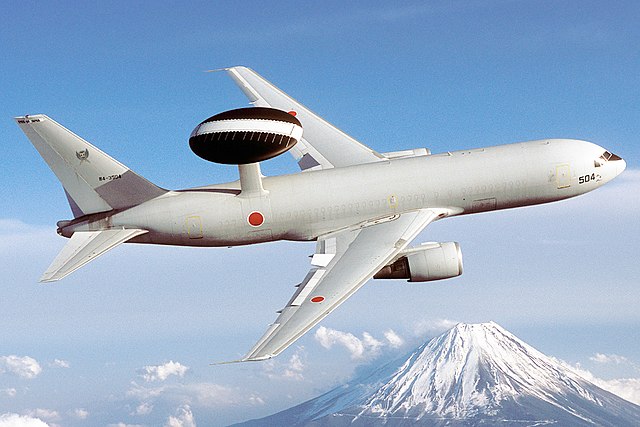The Boeing E-3 Sentry is an American airborne early warning and control (AEW&C) aircraft developed by Boeing. E-3s are commonly known as AWACS. Derived from the Boeing 707 airliner, it provides all-weather surveillance, command, control, and communications, and is used by the United States Air Force, NATO, French Air and Space Force, Royal Saudi Air Force and Chilean Air Force. The E-3 has a distinctive rotating radar dome (rotodome) above the fuselage. Production ended in 1992 after 68 aircraft had been built.
Boeing E-3 Sentry
The piston-engined EC-121 Warning Star, military version of the Lockheed Constellation, saw service in the mid-1950s.
Welcome ceremony for first E-3 aircraft at Tinker AFB in 1977
Close-up rotodome revolving at 6 revolutions per minute.
Airborne early warning and control
An airborne early warning and control (AEW&C) system is an airborne radar early warning system designed to detect aircraft, ships, vehicles, missiles and other incoming projectiles at long ranges, as well as performing command and control of the battlespace in aerial engagements by informing and directing friendly fighter and attack aircraft. AEW&C units are also used to carry out aerial surveillance over ground and maritime targets, and frequently perform battle management command and control (BMC2). When used at altitude, the radar system on AEW&C aircraft allows the operators to detect, track and prioritize targets and identify friendly aircraft from hostile ones in real-time and from much farther away than ground-based radars. Like ground-based radars, AEW&C systems can be detected and targeted by opposing forces, but due to aircraft mobility and extended sensor range, they are much less vulnerable to counter-attacks than ground systems.

A Royal Air Force Boeing E-3 Sentry over North Yorkshire
Wellington Ic "Air Controlled Interception" showing rotating radar antenna
Lockheed EC-121M one of the first AEW aircraft
E-767 of the Japan Air Self Defense Force








